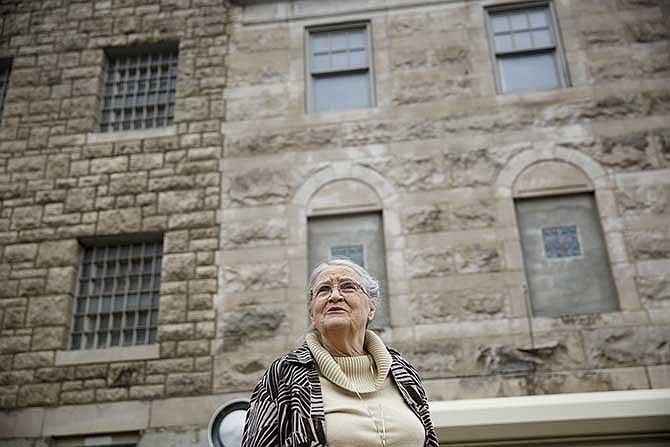Delores Shirley has enjoyed the reaction she gets when she tells people, "I was born in jail."
But it was Shirley who was reacting this week, when she stood in what likely was the front bedroom in 1938, when her mother, Sophie Walz, delivered her last child in the Cole County Sheriff's House.
Shirley's five older siblings moved into the newly-built house, when their father Buck Walz was elected sheriff in 1936.
Although only age 2 when the family moved out after Harry Mackey won the sheriff's race in 1940, Shirley has held a fondness for her unique place of birth.
Now a Eugene resident, she was eager to see inside the building before the Cole County Commission makes a decision April 16 about razing the 78-year-old, stone structure.
"I gotta check this out before they tear it down, which I hope they don't do," she said.
Her brothers talked about playing ball in the alley.
And her sister remembers sitting with her parents on the porch facing Monroe Street and looking out the bedroom window as prisoners were brought in the former entrance north of the house.
The family of eight lived in the modest-sized home, in addition to an aunt, a lady who helped with cooking and cleaning, and an occasional deputy who would also stay as guests.
The home struck Shirley as much smaller than she had imagined.
"I didn't expect it to be so small," she said, looking around the area that was converted to office space in the 1960s.
From family photos, Shirley knew her mother was responsible for cooking meals for the inmates and doing the jail laundry.
"There was a wonderful picture of a big, old stove and Mom by a big washing machine," she said.
But evidence of the kitchen in her photos is long gone. The basement sallyport area seemed the likely candidate from her tour.
She was told her father, who always made a big deal about holidays, sent the inmates home for Christmas.
And the family never worried about criminals only a wall and stairwell away, Shirley recalled.
"Their crimes were probably not as hardened as they are today," she said.
Combining the sheriff's house with the jail was common practice in the late 1800, especially in rural areas.
"By combining the residence and the jail, the county saved money by eliminating the need for round-the-clock jailers," according to the National Register nomination for the Maries County Jail and Sheriff's Residence, Vienna.
"Most of the inmates of the jail were local ner'-do-wells and petty criminals," the Maries County nomination continued. "This is evident by the fact that many of the inmates took their meals with the sheriff and his family.
"If there had been a serious criminal element in the county, it is doubtful that the sheriff would have exposed his family to the dangers inherent with living in a jail setting."
The times were so different, the nomination says, sheriff's wife Oma Parker would hand off her fussy baby to frequent inmate named Tade Nelson, so she could complete meals or chores.
When the Ripley County Jail, Sheriff's Office and Sheriff's Residence were built in 1899 in Doniphan,"the sheriff served primarily as a tax collector," its national register nomination said.
"The sheriff was often out of the office on business, since the sheriff also had to transport all prisoners to or from other jails or to the state penitentiary," the Ripley County nomination said. " The jail was often under the sole custody of the sheriff's family.
"If the sheriff's family was away, prisoners were locked in cells within the jail without supervision and were on their own until someone returned."
The Cole, Maries and Ripley county historic sheriff's houses are among about 10 remaining examples of this more peaceful incarceration era in Missouri. Most have been repurposed as museums.
The most notable probably is the Jackson County Jail, Marshall's House and Museum in Independence. Built in 1859, it was restored in 1959. Frank and Jesse James spent time in these cells in President Harry Truman's hometown.
The Vernon County Jail, Sheriff's House and Office built about 1870 in Nevada was restored in 1964 and is now the Bushwhacker Museum.
A unique "rotary jail" design was preserved at the 1888-built Daviess County Rotary Jail and Sheriff's Residence in Gallatin.
In Iron County, the sheriff's house and jail were preserved as part of an entire community historic complex. And Laclede and Ralls counties converted theirs to museums.
The Linn County Jail and Sheriff's Residence was constructed in 1871 and restored a century later.
"Today the building is a symbol of pride and history in Linneus," the Linn County National Register nomination said. "When the jail ceased its official duties of home and detention center in the early 1970s, it was given a thorough cleaning and furnished with nineteenth and early twentieth century period furniture, including the original sheriff's desk and chair from the 1870s."

